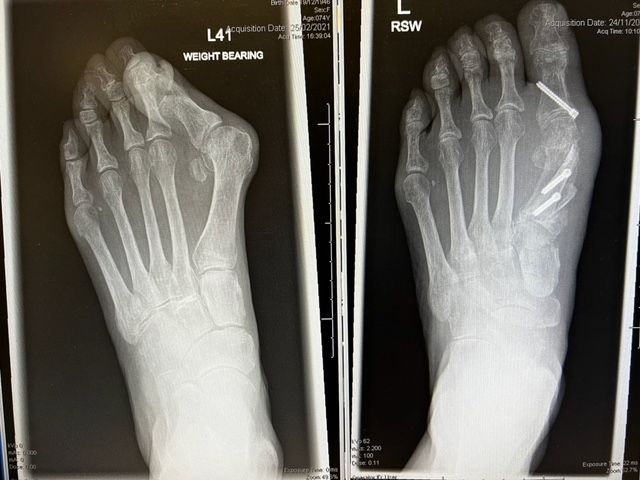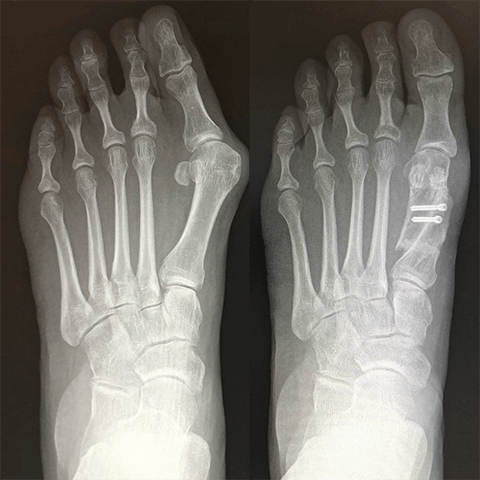Bunion Surgery
Are you fed up with shape of your foot, or only being able to fit your feet into ugly shoes? Do you have a painful bump on the side of the base of your big toe, or are you worried that your big toe is now in danger of crossing over the other toes?
Does the angle of your big toe cause rubbing or sores? If so, you may have a bunion. I understand how frustrating this can be for you, and as a bunion surgeon, I’ve helped hundreds of patients just like yourself.
REQUEST AN APPOINTMENT
What is a bunion?
A bunion is a painful area on the side of the base of a toe – usually the big toe, although it can also affect the little toe. The toe becomes angled so that instead of pointing straight ahead, it begins to point inwards. This can become a problem because the bunion can rub against the side of your shoe, or the big toe itself can rub against other toes.
What causes bunions?
Truth is, we’re not entirely sure, but there may be a genetic component to it (do your feet look like your Mum’s feet?), or it may have been contributed to the shoes you wore when you were younger. Some people believe that wearing narrow or pointy shoes can generate bunions.
Bunions are really common – around one in three of us will develop a bunion, and they are also more common in women. If you’re a diabetic, and you have a bunion, you may be more at risk of an ulcer forming where rubbing occurs.
What causes bunions?
Bunions are really common – around one in three of us will develop a bunion, and they are also more common in women. If you’re a diabetic, and you have a bunion, you may be more at risk of an ulcer forming where rubbing occurs.
What are the symptoms of a bunion?
Many people will complain of pain and redness around the base of the big toe, or a bony lump.
Sometimes there will be rubbing or sores where the big toe touches the other toes, or you may get a callus (hard skin) building up around the side of the toe.
The shifting over of the big toe may also crowd the second toe and cause it to hammer up, which can create rubbing on the top of the joint of the second toe.
Very occasionally, the big toe becomes so bent over that it starts to cross over the other toes.
Are any tests needed to diagnose a bunion?
I’ll be examining you to see how you’re walking, how the toes move, and looking at their alignment, and whether any soft tissue irritation is now happening.
It is always necessary to do some X-rays, whilst you’re standing with the weight through your feet, as this will tell me about the angles of the toe deformities when your foot is loaded.
What treatment options are available for bunions?
In the first instance, many people try to cope with wearing broader shoes (that have more space for the toes at the front of the shoe – called the toe box). Sometimes, seeing a podiatrist or wearing silicone toe separators can help.
Once you have a bunion, it’s likely to slowly worsen over time; in other words, it won’t correct itself.
What surgery is possible for bunions?
This translates into less pain during day to day activities, the ability to wear any shoes you want to, and feet that look more normal.
Bunion surgery can be performed either through an incision (known as an open procedure), or via a much shorter incisions (which is known as minimally invasive surgery). Every patient is different, and not everyone is best served by minimally invasive surgery. Together we’ll talk through your preferences, and which option I believe makes the best sense, clinically.
Minimally invasive bunion surgery.
If you have a mild bunion, that a minimally invasive procedure may be a good option for you. The advantage is, that the incisions I need to make are much smaller than a traditional, longer, open incision.
Using X-ray to guide me, I make careful cuts in the metatarsal bone (which is called a ‘chevron osteotomy’) and I realign the bone to correct the deformity.
The new positioning is held in place with very small screws, that are buried into the bone, so that you’ll be unable to feel them after the operation. It’s carried out under a light general anaesthetic, and it’s a day case procedure, which means you get to go home later that day.
I have extensive experience with this particular operation, and the end result is a nicely shaped foot with minimal scarring.

Open bunion surgery.
Sometimes, the bunion is quite severe, and minimally invasive surgery might not be as successful, in which case, I’m likely to recommend an operation with a bigger incision, known as an open procedure or a ‘scarf osteotomy’.
This operation is again performed under a light general anaesthetic, I carefully make a ‘Z’ shaped cut in the big toe bones, trim the side of the joint, and realign the bones, fixing them in place with small screws.
Sometimes I will correct tightened soft tissues or hammering of an adjacent toe too. A very powerful correction can be achieved using this technique and it is still the gold standard in the UK for bunion correction.
The bone cuts made are very stable, so much so that you can walk on this straight away after surgery. Because of nerve blocks used there will be no pain after surgery.
What is the recovery like after bunion surgery?
To make sure you are comfortable after the surgery, I carry out some nerve blocks during the operation, which means your foot will be numb for several hours. Your foot will be covered by a dressing, and you’ll leave the hospital wearing a surgical shoe.
It’s important to look after the surgical work that has been done, and so I’d like you to remember the following
1
When you leave hospital, I want you to leave the dressing on, keeping it dry, until we meet again, two weeks later. You may find showering easier by covering it with a protective sleeve www.limboproducts.co.uk
2
Try to minimise your walking as much as possible for six weeks, and elevate it whenever you are sat, to help reduce swelling. If you need to mobile then using two crutches, so that you can totally take the weight off your foot, will help you to get about. It’s important to say that the patients who do best after the surgery, are those who rest the foot as much as they can in the early stages. ‘Toes above the nose’ where possible.
3
At two weeks, you and I will meet again, and I’ll remove the dressings, and check the incision site has healed. Sutures will be removed, and you can wash the foot now.
4
5
6
When it comes to driving, if you have an automatic car, and the surgery is on your left foot, you can drive from around two weeks. If you’re driving a manual car, or if the surgery is on your right foot, then it’s best to wait until you are able to wear normal shoes. Make sure you can do an emergency stop before you pull away.



What are the risks of bunion surgery?
Every kind of surgery brings with it a small amount of risk, although thankfully the vast majority of my patients do very well after surgery. The risks include possible infection, damage to nerves, the bones fracturing, moving out of alignment or not healing, and stiffness of the big toe.
Very rarely the bunion can come back, and this can happen in up to 1 in 10 people, but it’s more likely if you have surgery when you are very young e.g. under 18 or have an underlying condition such as joint hypermobility. If this happens, revision bunion surgery is successful.






